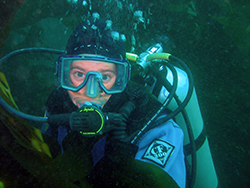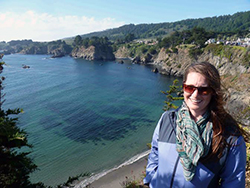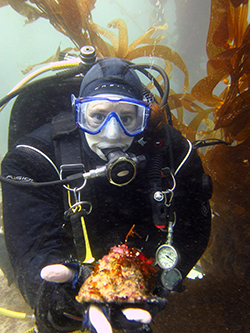


Cynthia Catton is an environmental scientist with the California Department of Fish and Wildlife’s Marine Region. Based in the Bodega Bay field office at the UC Davis Bodega Marine Laboratory, her main responsibilities are in Marine Invertebrate Fisheries and Conservation Research. She works primarily in kelp forest ecosystems throughout the state, with a particular focus on abalone populations. She conducts research to inform the management of the recreational red abalone fishery in northern California and the restoration of endangered species in southern California. She also contributes to research on Dungeness crab, sea urchins and sea cucumbers.
Cynthia earned her Bachelor’s degree in Zoology with a Marine Emphasis at the University of Washington, Seattle. She went on to earn a Master’s degree in Biological Oceanography and a doctorate in Biological Oceanography, both at Scripps Institution of Oceanography, University of California San Diego.
In 2012, she joined CDFW as an environmental scientist. Here, she represents the U.S. and Canada for the International Abalone Society, has served on the CDFW climate change working group and developed curriculum for the CDFW marine Climate Change College. Previously, Cynthia conducted marine life research in Washington, Australia and California, including work for the National Oceanic and Atmospheric Administration (NOAA) and National Research Council.
What inspired you to become a scientist?
I was one of those unusual people who knew I wanted to go into marine biology at an early age. Originally, I wanted to be an underwater photographer. I learned to dive when I was 16 and joined two Explorer Scout troops, one sponsored by a local dive club and another sponsored by NOAA. In the latter, I met marine biologists and got to ask all about their work.
I was fascinated by marine invertebrates early on, because they’re such odd, beautiful creatures, so I was searching for a way to be involved in the marine environment. In college, I decided to be a science major to support my photography interest, then discovered that I really liked research. So now, my photography supports my scientific research! I think that art and science are very complementary fields, and that using art to explain science can be very powerful.
What is your typical day at work like?
I can’t say I have a “typical” work day; my days are extremely varied and depend on the season. During field season—which used to be summer, but is expanding—I board a boat early in the morning to start a day of SCUBA work, counting and measuring abalone and other species in their environment.
I sometimes spend a lot of time driving to a site far from my lab, even to southern California. I may be outside in rubber boots and foul-weather gear to interview fishers about what they are catching, usually abalone or clams. At other times, I get to look at the data we collected during the field season and identify patterns of changes we’re seeing in populations. We use the data to understand why we’re seeing those changes and what they mean. Then, I can relay that information to the Fish & Game Commission, the public and the scientific community.
What is your favorite species to interact with or study? Why?
I can’t really name a favorite, though I have always really enjoyed marine invertebrates. My first interest was octopus, because they’re just an incredibly unusual species and fascinating to watch move and interact with the world. I’m pretty excited now because we have started a project in southern California where we are studying the interactions between octopus and abalone. We’re collaborating with an octopus biologist to help us with our efforts to restore endangered white abalone populations, because the octopus like to eat the abalone. We are learning about how to minimize octopus predation on the juvenile abalone that we are introducing to the ocean.
What is it about your work that you find the most interesting?
I really enjoy the variety in my work days. I appreciate being able to get out in the field and observe the organisms in their environment, collecting the data myself. That gives you important perspective for the analysis of the data later. It’s important to understand the nuances in the data when you are running the analysis, and it is likewise important for those in the field to keep in mind the requirements of the statistics. My work requires many different skill sets, and keeps me challenged.
What is the most rewarding project you’ve worked on for CDFW?
So much of what I do is really rewarding, but I think the most rewarding part is working as a team to solve problems. For example, I’m part of a very large collaboration on restoring white abalone populations in southern California. White abalone was the first marine invertebrate to be federally listed as endangered, and its population has been declining by 12 percent a year for over a decade. Using data from NOAA surveys of wild populations, I have estimated that we will have fewer than 1,000 white abalone in southern California by 2029. That just leaves us a little over a decade to move on re-establishing self-sustaining populations. It’s a complicated problem, but I get to work with people from lots of different backgrounds to come up with some really creative solutions. The first phase of the work has been developing a strong captive breeding program, focused here at Bodega Marine Lab and at partner aquaria in Southern California. We are now starting the next phase and will work to place these abalone into their natural environment. It’s really rewarding when we can work together and see the project grow successfully.
On the north coast, I am pulling together another team of folks to tackle the problems we are facing with the recent severe loss of bull kelp. We are working to understand the potential for the bull kelp to recover and how we can support that recovery. It is a real challenge to the fisheries and our small coastal communities, and I am pleased to lead this problem-solving effort. It’s really empowering and inspiring when we can get a whole community together—urchin divers, citizen volunteers and scientists — to come to the table and contribute their ideas and time.  Our blog article on The Perfect Storm has already attracted more than 50 volunteers.
Our blog article on The Perfect Storm has already attracted more than 50 volunteers.
If you had free reign and unlimited funding, what scientific project would you most like to do?
That’s fairly easy: save the kelp forest! It needs a lot of funding and experts to address different aspects of it. The issues we’re seeing with the kelp forest are a combination of really large-scale stressors to the system, hitting the kelp forest from many different angles. These kinds of compounding stressors on a system are what we expect to see more of with climate change. There are many large-scale changes to ecosystems that we are seeing occur around the world. The recent mass mortality of corals in the Great Barrier Reef is one example. The loss of the bull kelp forest in northern California is another huge issue, and I see this as our responsibility to respond to it. I am currently working on forming a broad collaboration of researchers to expand our understanding of the large-scale kelp forest dynamics, reaching up the coast into Alaska. If we can bring people and data together, we can work on fully understanding the problems we are facing and identifying the most effective solutions.
Do you have any advice for people considering careers in science or natural resources?
Follow your passion. Science, and natural resource management in particular, is a challenging career choice. Your passion will help motivate you to overcome those challenges, and it will inspire others to join you in your work.